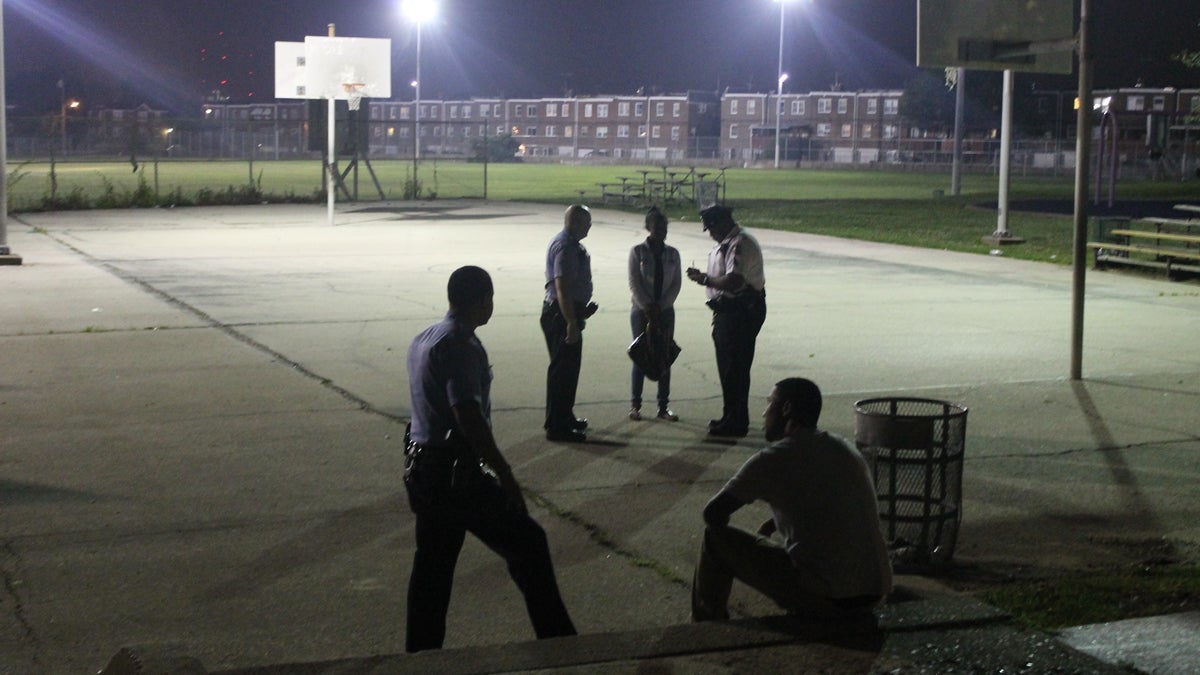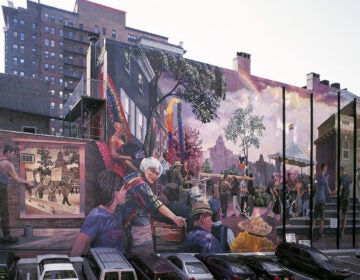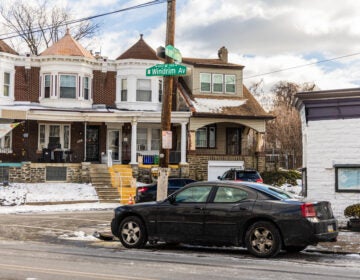Out on the police beat with Northwest Task Force officers

A call for a 'person screaming' results in a tense moment for the officers of the Northwest Task Force. (Matt Grady/WHYY)
In the back alleys of a residential section of West Oak Lane, Sgt. Tyreek Cunningham backs his patrol car into a driveway.
To the left of the Ford Taurus, a group of young black men congregates in front of a Middleton Street convenience store.
It could warrant further investigation, but Cunningham’s attention is directed to the opposite side of the street, where a crew of old heads is running an ad-hoc car-repair shop in the alley between two rows of houses.
The blocked alleyway is an aggravation for neighbors, but the denizens of the driveway are allegedly coordinating other, more illicit activities.
As Cunningham scans some patrol assignments on the car’s mobile data terminal, one of the young men approaches the car and asks the 31-year-old sergeant if he would like to participate in a music video that they’re filming.
Grabbing his hat from the center console, Cunningham gets out the car.
“This is my favorite part of the job,” he says. “Community policing.”
Successful formation
In Northwest Philadelphia, a small cadre of police officers is assigned to a unit charged with addressing spikes in crime.
Operating under the premise that heightened police presence reduces crime, the Northwest Task Force (NWTF) patrols high-crime areas in response to shootings and to prevent retaliatory acts of violence.
“They’re my rapid response force,” said Inspector James Kelly, who personally oversees the work of the NWTF.
The unit draws its officers from the four police districts that constitute the Northwest Police Division, which Kelly helms. Each of the PPD’s six patrol divisions has a similar task force operating within its boundaries.
In addition to aggressive patrol under Cunningham’s day-to-day supervision, the officers of the NWTF are tasked with cultivating street intelligence by knowing the major players in local crime and their criminal affiliations.
“They’re charged with doing a lot of things, and they’ve been very effective,” said Kelly.
On ‘The Grid’
In the Northwest, the NWTF was recently deployed in a swath of Northwest Philadelphia that straddles East Germantown and West Oak Lane.
Overlapping both the 14th and 35th Districts, “The Grid” one of the area’s highest crime sections.
Capt. John Fleming, commanding officer of the 14th District, described the effectiveness of the NWTF within his district’s share of “The Grid.”
“They have a great track record for shutting down crime,” Fleming observed. “They really set the tone for that area.”
Making connections
Checking out the video shoot, Cunningham sees that the kids are legit: They’ve got a digital camcorder and a decent portable lighting rig.
There’s no beef with the kids — one had approached Cunningham prior to the video, indicating that their efforts were aimed at “stopping the violence and increasing the peace” — but it’s an opportunity for him to listen to what they’re saying.
In the lyrics, the singers give a call-out to an individual known as “Fat Reef,” well-known to local players and police alike for his propensity for criminal enterprise.
Wanted by detectives, his whereabouts are presently unknown.
It’s this sort of street-level information that Kelly and Cunningham see as an important component of the NWTF’s mission.
How it came to be
The task force began when a series of shootings on the 6900 block of Forrest Ave. in 2010 triggered an enhanced response from police.
According to department sources, a bounty went out on a resident of that street, and would-be mercenaries from across the region descended upon that block trying to collect the reward.
Inspector Aaron Horne, then assigned to the Northwest division, created the task force because, in Cunningham’s words, he wanted to develop intelligence that could curtail the violence.
“The shootings stopped,” Cunningham explains, “but we stuck with it and have run with it ever since.”
What they’re doing now
In recent weeks, those runs have taken the NWTF to the Simons Recreation Center in West Oak Lane where, in response to a recent double shooting, officers were specifically assigned to patrol.
On the afternoon of July 16, gunfire erupted on the center’s playground, striking an 18-year-old man in the groin and a 19-year-old man in the thigh. Based upon forensic evidence found at the scene, at least 11 shots were fired.
Both victims were considered to be innocent bystanders. In addition, as many as 50 young adults and children were present at the time.
No arrests have been made in connection to the incident, but police sources suggest that the shooting resulted from an argument over a girl.
Needed: An open mind
While patrolling the streets near Simons one recent Friday night, a priority call comes over police radio for a “person with a gun” in East Germantown. As Cunningham is responding, a second call comes across the radio reporting a screaming person on the Simons playground.
Arriving on scene, Cunningham ambles up the steps behind the recreation center, where he sees two teenagers, a male and a female. The young woman is several steps ahead of the young man.
Calling out, “Miss, miss,” Cunningham catches up with her as two of his officers, Daniel Levitt and Michael Robertson, corral the young man.
A tense moment ensues, but everyone relaxes as it becomes apparent that the two were simply having an argument. Within minutes, all parties are laughing, with the general theme being the difficulties inherent in communications between the sexes.
Earlier in the shift, Cunningham remarked that initial requests for police intervention are seldom what they turn out to be.
“On this job,” he observes, “your mind has to be open to as many possibilities as possible.”
WHYY is your source for fact-based, in-depth journalism and information. As a nonprofit organization, we rely on financial support from readers like you. Please give today.




